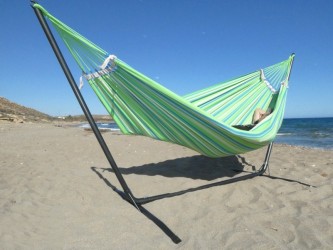- Pack













Including €0.80 for ecotax
Reference: INKAmojitoXL
Anthracite gray metal stand set and XL Mojito-colored hammock. The specific dimensions of this stand ensure an ideal curve of the hammock for better comfort. Sturdy, this stand will also be easy to assemble and disassemble for winter storage periods. The XL Mojito hammock is made in Brazil from recycled cotton. Spacious and pleasant to the touch, it will be ideal for solo or duo use. Machine wash at 40°
Anthracite gray metal stand set and XL Mojito-colored hammock. The specific dimensions of this stand ensure an ideal curve of the hammock for better comfort. Sturdy, this stand will also be easy to assemble and disassemble for winter storage periods. The XL Mojito hammock is made in Brazil from recycled cotton. Spacious and pleasant to the touch, it will be ideal for solo or duo use. Machine wash at 40°
When looking for a freestanding hammock, we are often first attracted by the price. However, there is a real difference between the models available online. Comfort, often overlooked, is essential to fully enjoy your hammock.
There are two main types of hammocks:
A poorly sized metal hammock stand can ruin the experience. Too tight? You’re curled up, uncomfortable, hanging like a banana. Well curved? You enjoy a soft, flat bed, perfectly suited for relaxation. This is where the ratio between the height and length of the stand comes into play. At Tropical Hamac, we have been working directly with metal hammock stand manufacturers for years to offer you structures truly adapted to hammocks without spreader bars.
We even designed our own models between 1995 and 2005, before the arrival of bentwood supports made possible by laminated wood. The result: our heights are specific, designed for optimal comfort – nothing like the standard supports on the market. See all our metal hammock stands: Metal hammock stand
We have gathered in one article all the concrete advantages of a hammock stand at home – a must-read before choosing! Why use a hammock stand ?
Metal can last for decades… provided it is given a minimum of care. The material used for this metal hammock stand is not stainless steel: slight rusting will therefore eventually appear over time, especially in areas of friction (tube joints, screws, etc.).
Here with us, on the Atlantic coast, in a saline climate, the first signs usually appear after 2 to 3 years.
No need to panic: there is a really effective paint to extend the lifespan of your surface. We recommend a 0.5 L can of Hammerite, available in most DIY stores. It is a thick paint, enriched with magnetized metal particles. Just one coat is enough, after a light sanding, with no need for rustproofing. The result: an additional 3 years of protection outdoors. Unsure whether to choose a wooden or metal surface? To make the right choice based on the required maintenance, check out our comprehensive article on the subject: Metal or Wood Hammock Stand – Maintenance
Just like with the stands, today you can find all kinds of things on the Internet when it comes to hammocks. As French people, we know very well how to choose a camembert from among 20 options... but for a comfortable and durable hammock, that's another story !
You can of course trust us — it’s our profession, our passion since 1988, long before the Internet. But here are a few simple benchmarks for comparison:
But two essential elements remain invisible at the time of purchase:
The quality of the thread : this is what we test first in each workshop.
The type of weaving : crucial for determining whether the canvas will loosen over time or remain taut.
The best threads often come from recycled cotton dyed industrially, under computer control, either hot or cold. Depending on the origin, some hammocks stretch so much that you literally end up trapped in a pocket.
We often see hammocks sold as "ideal for outdoor use." The names of their materials sound appealing, but they are very often 100% polyester: in other words, plastic. It's hot, sometimes static, unpleasant on the skin, and UV rays quickly degrade the fibers. Even after a few washes, they age poorly, and mold still finds a place to grow. And don't forget: your skin is in direct contact with the fabric. You might as well give it a soft and natural hammock !
A hammock is a textile, and as such, it is washed accordingly. A Brazilian who sleeps in his hammock every day washes it every 10 to 15 days. For us, who often use it outdoors, the ideal is to wash it once a year, at the end of the season.
Here are our recommendations:
For more practical tips and to avoid mistakes, feel free to watch our video dedicated to using a hammock: The 6 tips.
Quality, ethics, sustainability, comfort, and durability over time. This is the promise of Tropical Hamac – the passion for hammocks since 1988.
Data sheet
